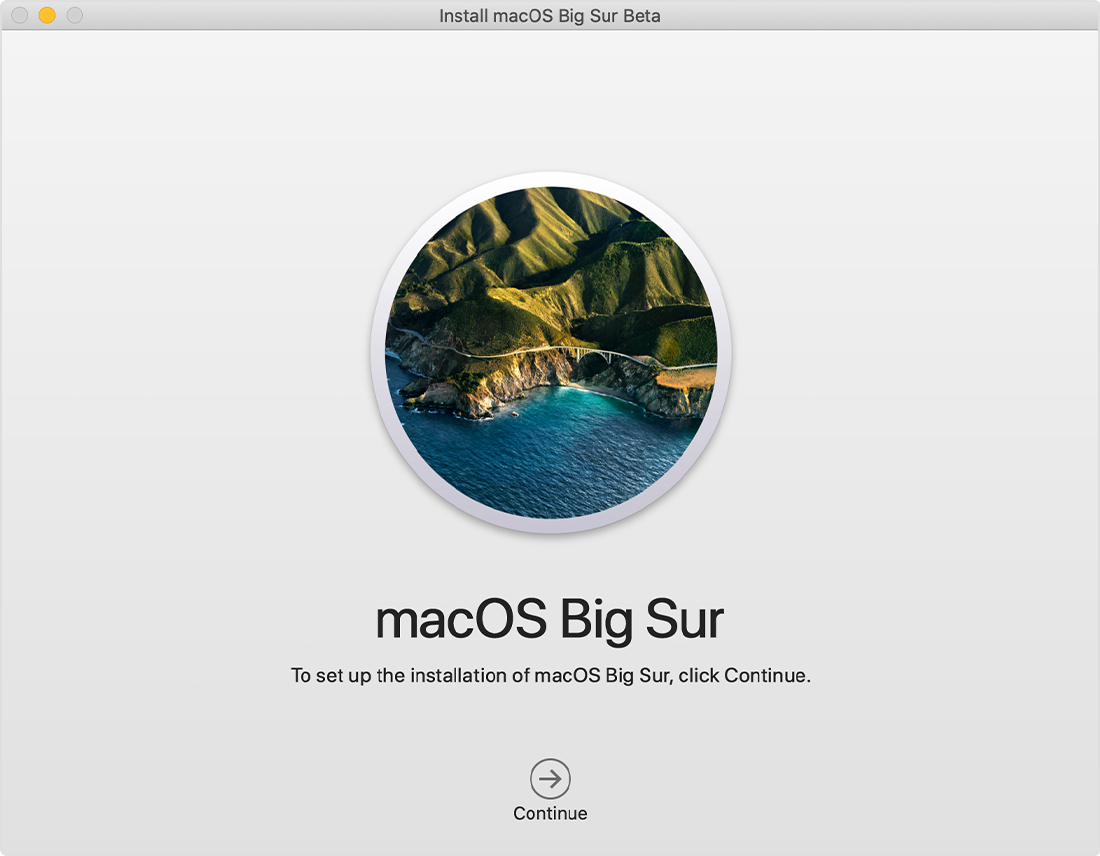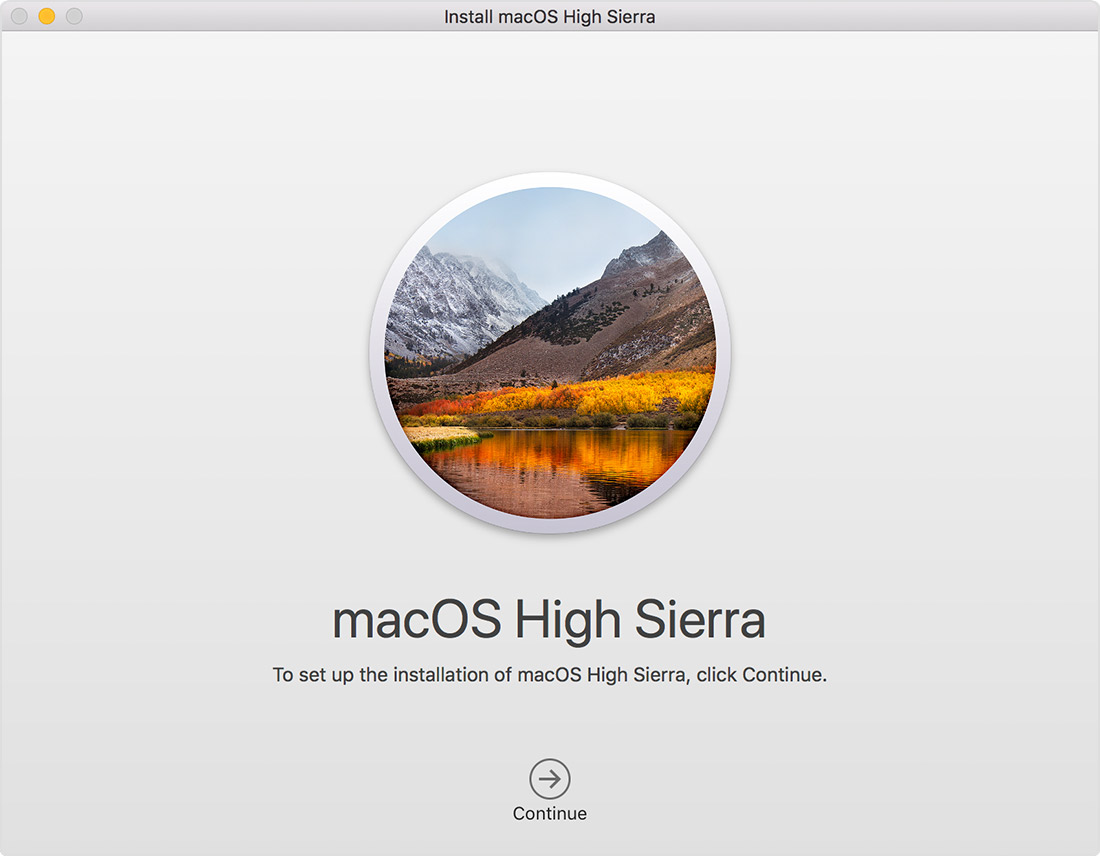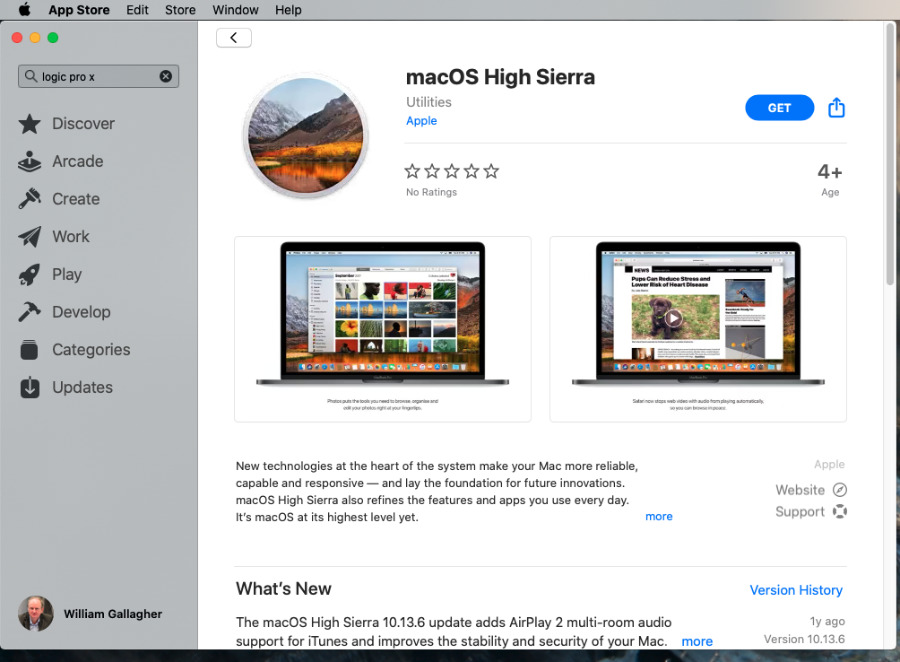ACS Composite Offers New C8 Corvette Z51 Rear Spoiler Wicker Upgrade: Video; Apple Car Won’t Arrive Earlier Than 2025 According To Analyst. 2022 Chevy Silverado And GMC Sierra To Drop 4.3L V6. Apr 24, 2018 Why Should We Upgrade to macOS High Sierra? Apple released the latest macOS, High Sierra, and added some new features including a new and improved Apple File System (AFPS), a faster browser, stellar graphics, better gaming capabilities and VR support. MacOS 10.13 is absolutely worthwhile to upgrade your Mac. MacOS High Sierra System Compatibility. Apple's MacOS High Sierra update offers lots of behind-the-scenes changes that should make the Apple's desktop OS easy to use. High Sierra might disappoint those looking for whizzy new features. Feb 05, 2021 If you're using OS X El Capitan v10.11.5 or later and your App Store preferences or Software Update preferences are set to download new updates when available, macOS Big Sur will download conveniently in the background, making it even easier to upgrade.
macOS Big Sur elevates the most advanced desktop operating system in the world to a new level of power and beauty. Experience Mac to the fullest with a refined new design. Enjoy the biggest Safari update ever. Discover new features for Maps and Messages. Get even more transparency around your privacy.
Chances are, your Mac can run macOS Big Sur
The following models are supported:
- MacBook (2015 or later)
- MacBook Air (2013 or later)
- MacBook Pro (Late 2013 or later)
- Mac mini (2014 or later)
- iMac (2014 or later)
- iMac Pro (2017 or later)
- Mac Pro (2013 or later)
To see which model you have, click the Apple icon in your menu bar and choose About This Mac.
Make sure you’re ready to upgrade.
Before you upgrade, we recommend that you back up your Mac. If your Mac is running OS X Mavericks 10.9 or later, you can upgrade directly to macOS Big Sur. You’ll need the following:
- OS X 10.9 or later
- 4GB of memory
- 35.5GB available storage on macOS Sierra or later*
- Some features require an Apple ID; terms apply.
- Some features require a compatible internet service provider; fees may apply.
Upgrading is free and easy
Upgrading from macOS Catalina 10.15 or Mojave 10.14?
Go to Software Update in System Preferences to find macOS Big Sur. Click Upgrade Now and follow the onscreen instructions.
Upgrading from an older version of macOS?
If you’re running any release from macOS 10.13 to 10.9, you can upgrade to macOS Big Sur from the App Store. If you’re running Mountain Lion 10.8, you will need to upgrade to El Capitan 10.11 first.
If you don’t have broadband access, you can upgrade your Mac at any Apple Store.
- OS X 10.9 or later
- 4GB of memory
- 35.5GB available storage on macOS Sierra or later*
- Some features require an Apple ID; terms apply.
- Some features require a compatible internet service provider; fees may apply.
For details about your Mac model, click the Apple icon at the top left of your screen and choose About This Mac. These Mac models are compatible with macOS Big Sur:
- MacBook (2015 or later)
- MacBook Air (2013 or later)
- MacBook Pro (Late 2013 or later)
- Mac mini (2014 or later)
- iMac (2014 or later)
- iMac Pro (2017 or later)
- Mac Pro (2013 or later)
Siri
Requires a broadband Internet connection and microphone (built-in or external).
Hey Siri
Supported by the following Mac models:
- MacBook Pro (2018 or later)
- MacBook Air (2018 or later)
- iMac Pro (2017 or later)
Dictation, Voice Control and Voice Memos
Requires a microphone (built-in or external).
Spotlight Suggestions
Requires a broadband internet connection.
Gestures
Requires a Multi-Touch trackpad, Force Touch trackpad, Magic Trackpad or Magic Mouse.
Force Touch gestures require a Force Touch trackpad.
VoiceOver gestures require a Multi-Touch trackpad, Force Touch trackpad or Magic Trackpad.
Photo Booth
Requires a FaceTime or iSight camera (built-in or external) or USB video class (UVC) camera.
FaceTime
Audio calls require a microphone (built-in or external) and broadband internet connection.
Video calls require a built-in FaceTime camera, an iSight camera (built-in or external) or a USB video class (UVC) camera; and broadband internet connection.
Apple TV
High dynamic range (HDR) video playback is supported by the following Mac models:
- MacBook Pro (2018 or later)
- iMac Pro (2017 or later)
- Mac Pro (2019) with Pro Display XDR
Dolby Atmos soundtrack playback is supported by the following Mac models:
- MacBook Air (2018 or later)
- MacBook Pro (2018 or later)
Sidecar
Supported by the following Mac models:
- MacBook (2016 or later)
- MacBook Air (2018 or later)
- MacBook Pro (2016 or later)
- Mac mini (2018 or later)
- iMac (late 2015 or later)
- iMac Pro (2017 or later)
- Mac Pro (2019)
Supported by all iPad models with Apple Pencil support:
- 12.9-inch iPad Pro
- 11-inch iPad Pro
- 10.5-inch iPad Pro
- 9.7-inch iPad Pro
- iPad (6th generation or later)
- iPad mini (5th generation)
- iPad Air (3rd and 4th generation)
Apple Upgrade To Sierra Leone
Continuity Camera
Requires an iPhone or iPad that supports iOS 12 or later.
Continuity Sketch and Continuity Markup
Requires an iPhone with iOS 13 or later or an iPad with iPadOS 13 or later.
Handoff
Requires an iPhone or iPad with a Lightning connector or with USB-C and iOS 8 or later.
Instant Hotspot
Requires an iPhone or iPad with cellular connectivity, a Lightning connector or USB-C, and iOS 8.1 or later. Requires Personal Hotspot service through your carrier.
Universal Clipboard
Requires an iPhone or iPad with a Lightning connector or with USB-C, and iOS 10 or later.
Auto Unlock
Requires an Apple Watch with watchOS 3 or later or an iPhone 5 or later.
Approve with Apple Watch
Requires an Apple Watch with watchOS 6 or later or an iPhone 6s or later, with iOS 13 or later.
Apple Pay on the Web
Requires a MacBook Pro or MacBook Air with Touch ID, an iPhone 6 or later with iOS 10 or later, or an Apple Watch with watchOS 3 or later.
Phone Calling
Requires an iPhone with iOS 8 or later and an activated carrier plan.
SMS
Requires an iPhone with iOS 8.1 or later and an activated carrier plan.
Home
Requires an iPhone with iOS 12 or later and a configured Home app.
AirDrop
AirDrop to iOS and iPadOS devices requires an iPhone or iPad with a Lightning connector or with USB-C and iOS 7 or later.
AirPlay

AirPlay Mirroring requires an Apple TV (2nd generation or later).
AirPlay for web video requires an Apple TV (2nd generation or later).
Peer-to-peer AirPlay requires a Mac (2012 or later) and an Apple TV (3rd generation rev A, model A1469 or later) with Apple TV software 7.0 or later.
Time Machine
Requires an external storage device (sold separately).
Maps electric vehicle routing
Requires an iPhone with iOS 14 and a compatible electric vehicle.
Maps licence plate restrictions
Requires an iPhone running iOS 14 or an iPad running iPadOS 14.

Boot Camp
Allows Boot Camp installations of Windows 10 on supported Mac models.
Exchange Support
Requires Microsoft Office 365, Exchange 2016, Exchange 2013 or Exchange Server 2010. Installing the latest Service Packs is recommended.
Windows Migration
Supports OS X 10.7 or later and Windows 7 or later.
App Store
Available only to persons aged 13 or older in the U.S. and many other countries and regions.
Photos

The improved Retouch tool is supported on the following Mac models:
- MacBook Pro (15-inch and 16-inch models) introduced in 2016 or later
- iMac (Retina 5K models) introduced in 2014 or later
- iMac (Retina 4K models) introduced in 2017 or later
- iMac Pro (2017 or later)
- Mac Pro introduced in 2013 or later
- Apple Books
- Apple News
- App Store
- Automator
- Calculator
- Calendar
- Chess
- Contacts
- Dictionary
- DVD Player
- FaceTime
- Find My
- Font Book
- Home
- Image Capture
- Launchpad
- Maps
- Messages
- Mission Control
- Music
- Notes
- Photo Booth
- Photos
- Podcasts
- Preview
- QuickTime Player
- Reminders
- Safari
- Siri
- Stickies
- Stocks
- System Preferences
- TextEdit
- Time Machine
- TV
- Voice Memos
- Activity Monitor
- AirPort Utility
- Audio MIDI Setup
- Bluetooth File Exchange
- Boot Camp Assistant
- ColorSync Utility
- Console
- Digital Color Meter
- Disk Utility
- Grapher
- Keychain Access
- Migration Assistant
- Screenshot
- Screen Time
- Script Editor
- Sidecar
- System Information
- Terminal
- VoiceOver Utility
- Arabic
- Catalan
- Croatian
- Simplified Chinese
- Traditional Chinese
- Traditional Chinese (Hong Kong)
- Czech
- Danish
- Dutch
- English (Australia)
- English (UK)
- English (U.S.)
- Finnish
- French
- French (Canada)
- German
- Greek
- Hebrew
- Hindi
- Hungarian
- Indonesian
- Italian
- Japanese
- Korean
- Malay
- Norwegian
- Polish
- Brazilian Portuguese
- Portuguese
- Romanian
- Russian
- Slovak
- Spanish
- Spanish (Latin America)
- Swedish
- Thai
- Turkish
- Ukrainian
- Vietnamese
| Developer(s) | Apple Inc. |
|---|---|
| Stable release | |
| Operating system | macOS |
| Type | Remote Access Software |
| License | Proprietary |
| Website | www.apple.com/remotedesktop/ |
Apple Remote Desktop (ARD) is a Macintosh application produced by Apple Inc., first released on March 14, 2002, that replaced a similar product called Apple Network Assistant.[1] Aimed at computer administrators responsible for large numbers of computers and teachers who need to assist individuals or perform group demonstrations, Apple Remote Desktop allows users to remotely control or monitor other computers over a network.
Releases[edit]
The original release, which used the User Datagram Protocol (UDP) on port 3283, allowed remote computers (running Mac OS 8.1 or later) to be observed or controlled from a computer running macOS. It also allowed remote computers to be restarted or shutdown, to have their screens locked or unlocked, or be put to sleep or awakened, all remotely. Version 1 also included simple file transfer abilities that would allow administrators to install simple applications remotely, however to install applications that required the use of an installer the administrator would have to run the installer manually through the client system's interface.
Version 1.1 (released August 20, 2002) introduced the ability to schedule remote tasks.
Apple Upgrade To Sierra Version
Version 1.2 (released April 2, 2003) added a number of features that were designed to ease the administration of a large number of computers. Software could now be installed remotely on a number of machines simultaneously, without using the client system's interface. The startup disk on remote computers can also be changed, setting them to boot from a NetBoot server, a Network Install image, or a partition on their own drives. The client ARD software could also now be upgraded remotely to allow administrators to take advantage of new features without having to visit each individual computer.
Apple released a minor update on December 16, 2003 that brought ARD to 1.2.4. This update concentrated on security, performance and reliability.
On June 21, 2004 Apple announced Apple Remote Desktop 2 (released in July), which was designed to use the VNC protocol (with many private extensions) instead of Apple's original ARD protocol. This allows the ARD administration software to observe and control any computer running VNC-compatible server software (such as Windows and Unix systems) not just Macs and conversely allowing standard VNC viewing software to connect to any Mac with the ARD 2 software installed and VNC access enabled. This version also uses the Transmission Control Protocol (TCP) for most functions (on ports 5900 and 5988), which is designed to be more reliable than the UDP used in ARD 1.[2] Another significant addition to ARD 2 was the Task List, that allows remote tasks to be queued and monitored, reporting their status (such as Succeeded or Failed). This release also dropped support for older versions of the Mac OS, requiring 10.2.8 or higher.
On October 11, 2004 Apple released version 2.1 which improved on a number of existing features while adding the ability to view observed or controlled computers in full screen, the ability to see the displays of computers with more than one monitor and support for mouse right-click and scroll-wheels.[3]
On April 29, 2005 Apple released version 2.2 which added support for Mac OS X 10.4 along with several other bug-fixes and improvements to reliability.[4]
On April 11, 2006 Apple released version 3.0 which is now a Universal Binary and features improved software upgrade functionality, Spotlight searching, as well as increased throughput and encryption for file transfers, and Automator support.
On November 16, 2006 Apple released version 3.1 which provides support for the new Intel-based Xserve Lights Out Management feature.
On October 18, 2007 Apple released version 3.2 which introduced Mac OS X 10.5 support and compatibility for third party VNC viewers and servers.
On August 20, 2009 Apple released version 3.3 which fixed many bugs and allowed function keys and key combinations to be sent to the remote computer instead of the local machine.[5]
On January 6, 2011 Apple released version 3.4 which provides compatibility with the Mac App Store.[6]
On July 20, 2011 Apple released version 3.5 which provides compatibility with Mac OS X 10.7.[7]
On October 22, 2013 Apple released version 3.7 which provides compatibility with OS X 10.9, multiple monitors, and enhancements to remote copy/paste.[8]
On January 27, 2015 Apple released version 3.8, which primarily added support for OS X 10.10, while also including various user interface improvements, a new icon, stability improvements and the ability to update the application using the Mac App Store, even if the application was not originally installed from that source. This version now requires OS X 10.9 or above.[9]
On February 21, 2017, Apple released version 3.9, which heightened communications security between local and remote computers (including a Preferences checkbox to allow communication with pre-3.9 clients), added support for the MacBook Pro TouchBar, addressed various stability issues, allowed the user to export and import an encrypted list of computers with user credentials, and debuted the ability to use an 'Assistance Cursor' to call attention to items for the remote user. This version now requires OS X/macOS 10.10.5 or later.[10]
Encryption[edit]
Prior to version 3, ARD encrypted only passwords, mouse events and keystrokes; and not desktop graphics or file transfers. Apple therefore recommended that ARD traffic crossing a public network should be tunnelled through a VPN, to avoid the possibility of someone eavesdropping on ARD sessions.[11]
ARD 3.0 has the option of using AES 128 bit, the same as a basic SSH server.
ARD 3.9 included as yet unspecified enhancements to communications security that made the native mode incompatible with previous-version clients. A Preferences checkbox was provided in the Apple Remote Desktop app to explicitly allow communications with older clients. ARD 3.9.2 made the use of this checkbox optional for seeing clients in the list.[10]

Apple Upgrade To High Sierra
Legal[edit]
In November 2017, the United States International Trade Commission announced an investigation into allegations of patent infringement with regard to Apple's remote desktop technology. Aqua Connect, a company that builds remote desktop software, has claimed that Apple infringed on two of its patents. [12]
Restrictions[edit]
ARD does not support reverse connections to listening VNC viewers.[citation needed]
See also[edit]
References[edit]

Upgrade To Sierra From El Capitan
- ^Network Assistant 4.0.3 available - Macworld
- ^'Well known TCP and UDP ports used by Apple software products'. docs.info.apple.com. October 18, 2011. Retrieved January 12, 2012.
- ^'About the Apple Remote Desktop 2.1 Update'. docs.info.apple.com. July 28, 2011. Retrieved January 12, 2012.
- ^'About the Apple Remote Desktop 2.2 Update'. docs.info.apple.com. August 26, 2011. Retrieved January 12, 2012.
- ^'About Apple Remote Desktop 3.3'. Support.apple.com. September 16, 2009. Retrieved January 12, 2012.
- ^'About Apple Remote Desktop 3.4'. Apple Inc. January 6, 2011. Retrieved January 12, 2012.
- ^'About Apple Remote Desktop 3.5'. Apple Inc. July 20, 2011. Retrieved January 12, 2012.
- ^'About Apple Remote Desktop 3.7'. Apple Inc. July 26, 2016. Retrieved October 26, 2019.
- ^About Remote Desktop Admin 3.8 - Apple Support
- ^ ab'About Apple Remote Desktop Client and Admin'. Apple Support. Retrieved April 1, 2017.
- ^'LL0157.book'(PDF). Retrieved December 24, 2009.
- ^Orlowski, Andrew (November 15, 2017). 'US trade cops agree to investigate Apple's 'embrace and extend''. Retrieved November 16, 2017.
External links[edit]
Upgrade To El Capitan
